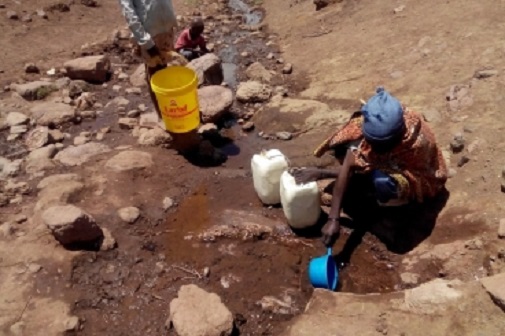
Sephareng, Lesotho | AFP |
For farmer Mohlakoane Molise, the view of the enormous Katse dam from his smallholding high in the mountains of Lesotho taunts him daily.
His country is suffering through its worst drought in 35 years, but the vast and vital water reserves remain out of reach, destined instead for export to neighbouring South Africa.
“I am very angry about that water, because it could benefit us, we could use it to water the crops when there is a drought. But that’s not happening,” the 65-year-old widower told AFP.
Kneeling in front of his round, thatch-roofed hut, he sorted through his maize, examining each grain, one-by-one.
The operation didn’t take long. His total annual harvest filled just two large sacks, in place of the usual dozen.
According to the World Food Programme (WFP), the 2016 harvest for Lesotho’s primary crop maize is estimated at 25,000 tonnes, a dramatic drop from last year’s 78,000-tonne haul.
Instead, the mountainous kingdom –- entirely landlocked by South Africa -– must import food from its larger neighbour.
But it too has been hit by the drought after the El Nino weather phenomenon wreaked havoc on the region’s rainfall patterns, and maize prices have sky-rocketed by 60 percent in the last year.
According to the United Nations, 40 million people across southern Africa risk malnutrition by next year’s harvest.
“From September, we’ll have nothing left and we’ll struggle to buy maize from the shop,” said Molise.
Below, the immense dark blue of the dam stood out in stark contrast to the bare, brown mountains.
‘It’s like a desert’
The valley here was flooded in the nineties to make way for Katse. The deal: hydroelectricity for impoverished Lesotho in exchange for a reliable water supply to the bustling cities of Johannesburg and Pretoria.
“There were fields around the river before the dam was built, and there were trees, but they are covered by water,” said Molise.
“Since the dam is here, it’s difficult to get water. The crops are very poor, even the grazing land. It’s like a desert.”
In Sephareng, the village tap has run dry for months. Residents must instead make their way up the mountain –- a good half-hour walk along a rocky trail –- to a communal pump. There, a feeble trickle of water fills their buckets, while their cows and donkeys drink from the small puddles left behind by a vanishing stream.
For its part, Africa’s second-largest dam is fulfilling its mandate, despite the drought.
“The level today is about 63.4 percent, which is quite low,” said Tatuku Maseatile, Katse acting branch manager for the Lesotho Highlands Development Authority (LHDA).
“We are still able to meet our annual targets in terms of both generation and water transfer.”
From his office high up on the soaring dam wall, he had an unparallelled view of the waters below.
“I do think people are benefiting from the dam,” he said, ticking the projects off: a water supply system, construction jobs, two industrial fishing projects, schools.
“And roads in the mountains, tarred roads brought by the project -– another direct spin-off -– and a clinic built and transferred to the government.”
Disastrous consequences
Along those tarred roads, women trudged uphill for hours to reach the clinic for the WFP’s monthly food distribution.
“We give them four packs each,” explained Mamakase Grace Sello, 21, a nutrition student interning with the WFP.
“It’s for lactating or pregnant mothers, and infants below the age of two. But we know that often the whole family eats some, including the fathers, even if they should not. The nutrients are for the babies.”
In a country where the overwhelming majority of families depend on their own crops for food and where nearly a quarter of the population is affected by AIDS, charities are predicting disastrous consequences by next year’s harvest.
Earlier this year, the Lesotho government declared the drought a natural disaster.
“I’ve never seen a drought like this,” said shepherd Ntoaesele Mashongoane, 32.
“This drought is really terrible, especially for the pregnant sheep. They don’t have enough grass and there’s no water.”
His flock moved down the steep mountainsides to the water’s edge for a drink –- a small consolation -– and the deep blue of the dam reflected the skies above, not a raindrop in sight.
 The Independent Uganda: You get the Truth we Pay the Price
The Independent Uganda: You get the Truth we Pay the Price



